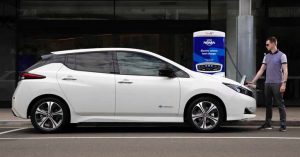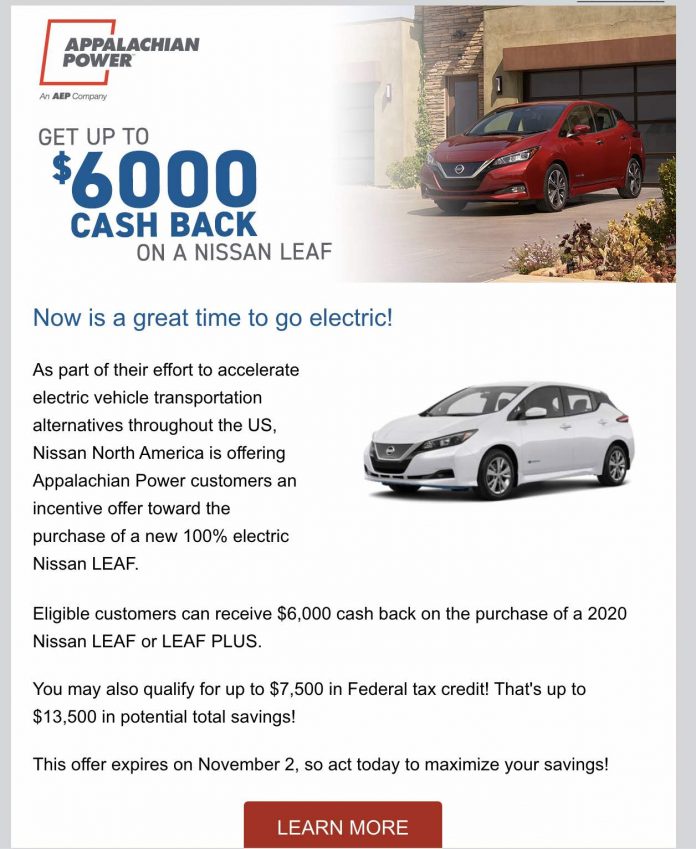When the only way you can get people to buy what you’re selling is to pay them to buy it, it’s time to reconsider making what you’re selling.
Unless, of course, you can force someone else to pay for it.
In the oddball past, businesses had to succeed or fail based on their being able to sell things people wanted to buy at a price they were willing to pay. But the electric car business is a political business and grubby old things like that are no longer considered.
The above is the context for commentary about Nissan’s half-off (almost) offer on a new Nissan Leaf electric car. The manufacturer of the least-expensive EV you can buy – base price $31,600 for the 150-mile range model; $38,200 for the “Plus” model that can go a little bit farther – wants to give buyers $6,000 cash back off that plus the egg-on of the $7,500 federal kickback for “$13,500 in potential savings!” as the offer exclamation-points it.
This being “part of the effort to accelerate electric vehicle transportation alternatives throughout the U.S.”
Actually, it opens a window on what you’ll be paying for “the effort to accelerate electric vehicle transportation throughout the U.S.”
Because this cannot go on without someone paying for it all. Guess who that’ll be?
Nissan – and it’s not just Nissan – can’t continue manufacturing EVs it can’t sell without lopping half (almost) off the MSRP. Without getting someone else to eat that loss. It is balance sheet math. It is why GM no longer manufactures the Pontiac Aztek.
Try, as a thought experiment, to conceive of GM continuing to manufacture the Aztek – and maintain Pontiac – via financially grotesque half-off (or almost) “incentives” to buy them. There would be a shareholder revolt. The automotive press would be merciless in its coverage. And most of all, it would not last because you can only hemorrhage so much blood before you die.
Unless, of course, you have access to a steady supply of fresh blood – provided via IV transfusion from unwilling donors.
It’s all of us – who will be bled to keep the EV alive. At least until the privately owned car is dead, for the majority of us. This being the political reason for “the effort to accelerate electric vehicle transportation throughout the U.S.”
It’s not stated that way, of course. But it’s academic. People in the main aren’t able to afford electric cars, leaving aside the question of their very dubious merits as cars. Nissan – and the rest – cannot afford to continue giving them away (even Tesla is discounting its cars – twice in the past month alone).
The government can – and will, if the Green New Deal becomes policy, as the Hair Plugged Man has promised it will – insist that people drive electric cars. It will regulate non-electric cars off the market or make them just as unaffordable as electric cars – perhaps even less affordable, as the Chinese have done via exorbitantly priced registration/license fees for non-electric cars. 
It can – and will – require that all new homes be outfitted with high-voltage wiring to facilitate at-home “fast” charging.
But someone’s got to pay for all of this and the problem is that most of us can’t.
And that’s why the Leaf doesn’t sell. It’s not because it’s a bad car. It’s a preposterously pricey car. Even with almost half lopped off the MSRP, the thing still isn’t an economically sensible alternative to a non-electric equivalent.
A non-electric Versa – a car about the same size and shape as a Leaf – can be bought for $14,830 and Nissan doesn’t have to cut the price in almost-half to get people to buy them. Probably because the Versa – at full sticker price, no haggling and no “incentives” – costs the buyer $3,270 less than the almost-half-off Leaf.
And it goes twice as far – almost three times as far on the highway – and does not require spending another $1,000-plus to get your house rewired, either.
The Leaf, even almost-half-off, still costs too much relative to what it costs buyers to own it. Including the cost of time, which can’t be rebated.
Teslas sell a little better because they are marketed as rich people’s toys. But there are only so many rich people who can afford such toys. That supply is drying up. Which is why Tesla has been discounting its cars so much all of a sudden. (The loss of the federal tax kickback has contributed to this by making Teslas cost closer to what they actually cost.)
This idea that EVs can be mass-market cars is either delusional or deliberate – the means by which almost everyone except the rich will be gotten out of cars without actually outlawing them.
Cars weren’t illegal in the old Soviet Union, either. You just didn’t see many of them being driven by the proletariat.
. . .
Got a question about cars, Libertarian politics – or anything else? Click on the “ask Eric” link and send ’em in!
If you like what you’ve found here please consider supporting EPautos.
We depend on you to keep the wheels turning!
Our donate button is here.
If you prefer not to use PayPal, our mailing address is:
EPautos
721 Hummingbird Lane SE
Copper Hill, VA 24079
PS: Get an EPautos magnet or sticker or coaster in return for a $20 or more one-time donation or a $10 or more monthly recurring donation. (Please be sure to tell us you want a magnet or sticker or coaster – and also, provide an address, so we know where to mail the thing!)
If you’d like an ear tag – custom made! – just ask and it will be delivered.
My latest eBook is also available for your favorite price – free! Click here. If that fails, email me at [email protected] and I will send you a copy directly!














So if I were to purchase an electric car and charge it at home every day, would my marxist power company continue to hector me over my energy consumption (which I pay for) and give me an “F” on the little “energy report card” that they send me periodically which goes straight to the shitcan unread?
Hi Baloney,
The first step is to get people into electric cars; having done that, the next step will be to ration electricity – either overtly or via rate increases that force you to “conserve” during “peak” times.
By far the great post I have read so far. Now we have no such thing. All you have to do now is lobby Washington D.C. to force the suckers to buy your product.
It’s not just EVs that are heavily discounted. I noticed last month that Ford was offering a $7000 rebate on it’s Ecosport compact SUV. The fine print revealed that the very generous rebate was on the 2WD with the 1.0 liter turbo triple.
No thanks. They’d have to double the rebate for me to even remotely consider that POS, and even then it’s not much more than an around-town go-kart.
The Powers-That-Be are in the process of killing personal transportation — by design. They want you all riding on a government bus or on a bicycle. Kids these days can’t afford either EV OR the ICE vehicles, let alone fix and maintain them. Kids used to bomb around in, and wrench on, old $500 pickup trucks in the 1970s. Doesn’t happen any more when a new truck costs $50,000 plus and has more amenities as standard equipment than a 1985 Cadillac did. Manual transmission? Haaaa… whazzat???
Kids are happy to do “bike sharing” and call Uber and Lyft today instead of owning cars. Are you fucking kidding me? I rode bicycles when I was a child. I don’t want to ride one, let alone “share” one, as an adult. And I don’t want to call some total stranger to drive me around and know my business.
I am increasingly feeling like a dinosaur, but f—k this shit. It’s turning into Mao’s China circa 1972 where everybody rode bicycles except for the party bigwigs, who drove around in armored limousines.
Hi X,
I’ve been feeling the same way lately as well. This is not America anymore – or even a shadow of it. The Diapering and related psychosis have eliminated almost everything that made life a semblance of normal. Just seeing all these Diapered freaks everywhere is an enervating visual and then you cognate that every one of those Diaper wearers either fervently beeeeelieves in all this insanity or no longer cares about preserving the semblance of America that made it worth getting out of bed in the morning.
So what kind of vehicles do buyers actually want?
It’s so damned clear, even a legally blind government worker could read this block-letter handwriting on the side of a freaking barn:
BUYERS TRAVELING ACROSS THE COUNTRY, PAYING RECORD PRICES FOR USED PICKUPS
https://www.cnbc.com/2020/10/19/used-pickups-selling-for-record-prices-amid-high-demand.html
CNBC calls it “a run on certain types of used vehicles, like full-size pickups.” Customers are scarfing ’em up like Charmin quilted, back in the glory days of the shutdown.
Meanwhile, there’s a broad and impressive array of electric pickups, from Tesla to Nikola to Lordstown to Hummer. But they’re all VAPORWARE.
You have to wonder whether the judicious application of a few kilovolts to the crania of a few malfunctioning regulatory minds would clarify some systematically warped perceptions.
I know Eric has mentioned something about this before but I don’t recall the answer: Are there any realistic electric cars out there at all? By which I mean an inexpensive no-frills runabout? It seems to me there could actually be a market for sort of an electric VW bug for city folk, students, couples just starting out. Just enough to get some groceries and run around town. I’d think that would be cheap to make, to buy, to maintain (for a while), and to insure. If there isn’t such a thing, why not? Is there actually some legislation against an electric care that makes sense?
“Care” should read “car” of course
Hi Bill,
There aren’t – but could be. The reason there aren’t is because the realistic EV you ask about would need to be very light and that makes it very hard to comply with government ssssssssssssaaaaaaaaaaafety standards. This is perhaps the major obstacle in the way of a realistic electric car, as weight is always the enemy of efficiency. In an EV the problem is compounded because weight is also the enemy of range – a function of being inefficient. A “gas hog” muscle car or truck has that issue, too – but it is less of a problem because even if the thing only gets 6 MPG and runs the tank dry in an hour of high-speed driving, one can refuel in less than 5 minutes. So practicality isn’t much affected. With the EV, you have limited range, long recharge time and high cost – a triple loser.
GovCo just plain screws up everything it touches, doesn’t it? Every single thing. Thank Gawd motorcycles were here before that cold finger gained power. May Ralph Nader rot.
Too bad we can’t buy this EV:
https://jalopnik.com/the-dacia-spring-electric-will-be-the-lowest-priced-ele-1845397900
The bicycle was invented because it was expensive to own a horse. A horse eats like a horse.
Then the saddle and tack, a place to stable the horse, starts to add up. Go buy a horse and saddle today and you might as well go buy a used car, you’ll be glad you did. A coach and four would be pricey.
The bicycle happened in the early 1800’s. Towards the end of the Little Ice Age bicycles became a means of transportation, cost less than a horse and the convenience made the velocipede a hit.
Persistent cold weather for about five centuries became the mother of invention.
James Watt improved the steam engine, which was used to pump air into the coal mines in England. The new and improved steam engine became 80 percent more efficient.
Rock oil changed all of that and made your post-modern existence a piece of cake.
Enjoy.
In Joost Meerloo’s analysis of false confessions and totalitarian regimes, The Rape of the Mind, he coins a phrase for the ‘dumbing down’ of critical resistance – menticide. “In the totalitarian regime,” he wrote, “the doubting, inquisitive, and imaginative mind has to be suppressed. The totalitarian slave is only allowed to memorise, to salivate when the bell rings.”
https://thecritic.co.uk/face-masks-make-you-stupid/“>Masks make you stupid
Are we there yet?
oops, well, the link is there.
Morning, drump!
I’d say “masks” are merely the outward manifestation of already-instilled stupidity. Or rather, servility – which is a kind of stupidity in that the servile mind acts (or refrains from acting) just because it is told to act -or not act – suppressing the judgment of its own mind.
And that’s a pretty fair working definition of stupid.
Once upon a time there was a thing called a free market. In that system the only way to gain wealth was to serve your fellow man, by offering a product they wanted or needed at a price they were willing to pay. Now we have no such thing. All you have to do now is lobby Washington D.C. to force the suckers to buy your product. Now the only way you can get wealthy is by doing exactly the opposite of serving your fellow man, and serve the corporate state instead.
The next thing we can count on…assuming there are enough Rubes out there to buy these EV’s….is additional additions to all of our power bills to pay for the “needed” infrastructure. Because you know the power companies are not investing to expand their grids now and it will be too late when electric cars cause the brown outs.
Indeed, Doug –
And, ironically, it’s a damned good reason to consider doing what it takes to divorce yourself from grid power before grid power increases in cost such that you’ll wish you had but can’t because demand for solar and such has ballooned the cost of that stuff, too.
“Try, as a thought experiment, to conceive of GM continuing to manufacture the Aztek – and maintain Pontiac – via financially grotesque half-off (or almost) “incentives” to buy them”
Unless of course you can make money on the financing. GMAC was the big cash cow in GM for decades.
Can’t imagine there are many people in Appalachian Power service territory that could afford to spend $38,200 on a car that is basically worth about $10,000 at most. It’s one of the poorest areas in the US.
I say its worth about $10,000 because the Versa is $14,830. I think that would have to be the max price to get people to consider it over the Versa due to its gimps.
It doesn’t help that the Leaf’s don’t age well either. Even gas powered Nissans age far better.
The Pontiac Aztek is a great example! However, I suddenly have a hankering for one after watching Breaking Bad… Need to find one in that unique infected piss green that Walter White ran his errands in!
“ Cars weren’t illegal in the old Soviet Union, either. You just didn’t see many of them being driven by the proletariat.”
A big reason why was by design. The Soviet Union and the rest of the Communist Bloc built warrens of stack-a-prole high-rise apartment buildings connected by electric trams for the workers, while the elite had dachas and ZILs.
The better for the KGB to spy on everyone, as well as punish them.
“We lose money on every transaction, but make it up in volume!”
This business plan didn’t end well for pets.com, but at least in the .com bubble pop it just screwed sucker investors. No way they’ll let that happen again. The upside was after the dust settled we had a global fiber optic network, several new programming languages, more reliable computers and millions of people who can program them. The infrastructure was built on bubble financing. This doesn’t seem to be happening with electric cars. Oh sure, Tesla has the best marketing in the world, but what about everyone else? VW talks about electric vehicles, but so far it’s pretty much just talk. Nissan has the Leaf. GM had the Volt but stopped production, ostensibly because it wasn’t profitable enough for GM. And were is all the VC money for building out the infrastructure? I see a few charging stations popping up, but what about the electricians advertising they’ll install your home charger? Where are the branded fast chargers (other than the proprietary Tesla)? What do the VC guys know but aren’t saying?
My guess is that government malinvestment is crowding out the venture capital, forcing a top-down strategy for electric cars, instead of letting a free market approach take hold. I see electric vehicles everywhere today. But they’re not on the highway, they’re on bike paths. Imagine a Vespa-inspired scooter, with all that space under the seat available for batteries. Small enough to fit several in a parking space, with easily installed low-voltage charging. Or, a removable battery pack could be carried up to the apartment, with an extra pack ready to be swapped out. In many parts of the world that would a fantastic solution for urban transportation. Market it with an ad inspired by Audrey Hepburn and Gregory Peck tooling around Rome.
But that doesn’t fit the bureaucratic mind’s model of transportation.
Asked an electrician friend the other day if he has installed any “fast” chargers. He hasn’t. Not a one he said.
I’m friends with the facilities manager for the regional office at work. Management (probably marketing, but we’ll go with management) wanted to install a few charging stations at one of the stores. The electricians had to pull a 480 V three phase line from the main disconnect over to the charger location! Took months to get all the permitting done, and another few months to get it installed and running. Not an easy job for sure.
Home “fast” chargers (still >4 hours from empty) aren’t going to be quite so bad, but most homes aren’t going to have a service drop up to the task, and almost none of the homes built before the 1980s, especially if they don’t have all electric heat, are going to have a distribution panel rated to handle the load. And even if they do, if they have electric baseboard heat I could see a situation where the total load with the charger running on a cold day could exceed the panel rating.
Hi RK,
My understanding is that a house which was not built with “fast” charging in mind will need to be updated to accommodate it; i.e., you can’t just run a cord to the 240V dryer outlet… right?